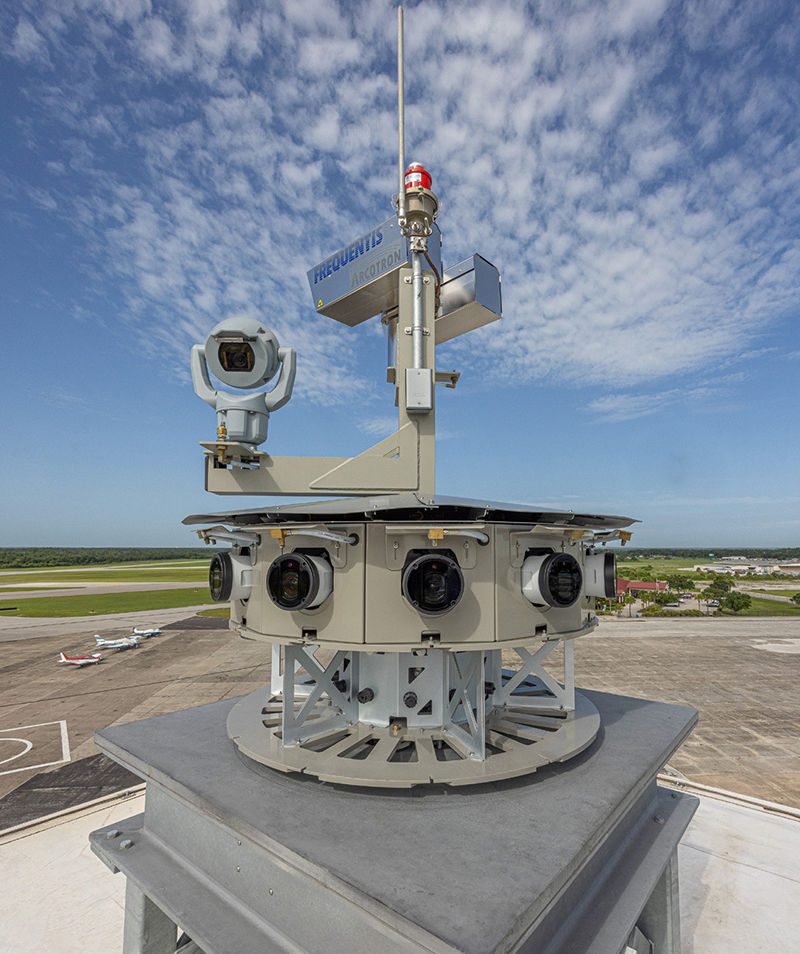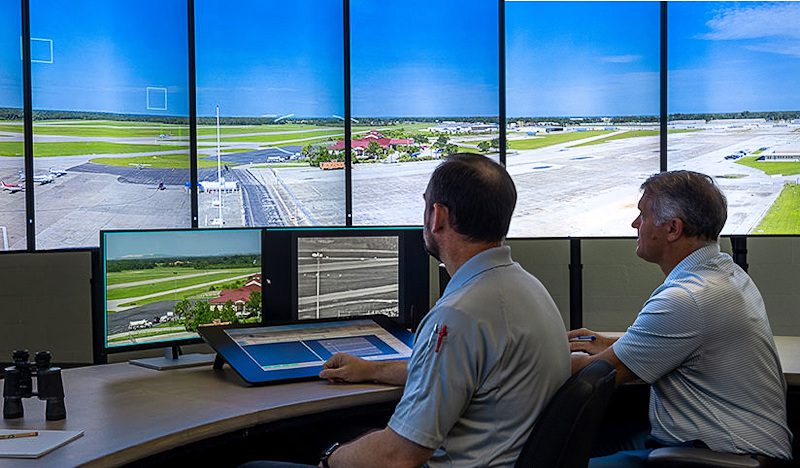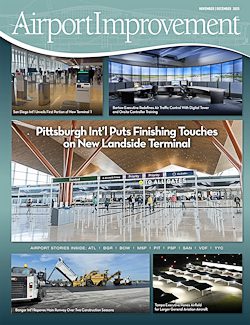The building where astronaut Buzz Aldrin once completed his flight training is now home to some of the most advanced air traffic control technology in the United States. Talk about another giant leap for mankind.
That building is at Bartow Executive Airport (BOW), a busy general aviation facility in Central Florida that is one of the first airports in the nation to operate a remote digital air traffic control tower. The new technology was implemented alongside an innovative training academy for controllers, turning BOW into a proving ground for the future of U.S. air traffic control.
An Issue 80 Years in the Making
For John Helms, executive director of the Bartow Airport Authority, the significant changes started with a practical—and pressing—problem.
| facts&figures
Project: Remote Digital Air Traffic Control Tower Location: Bartow Executive Airport, in Bartow, FL Owner/Operator: Funding for Tower System: $6.1 million from FL Dept. of Transportation (100%) Project Timeline: Engineer: Hanson Professional Services Inc. Construction: Hanson Professional Services Inc.; Crown Electric Inc.; Southeast Communications Inc. Technology Provider: Frequentis USA Inc. Technologies: Aircraft bounding boxes; projected runway approach slope lines; thermal cameras for low-visibility conditions (darkness, fog, low cloud cover, etc.); pan/tilt/zoom cameras; VFR visual reporting points display; pavement condition displays; etc. Key Advantages (vs. Traditional Towers): Less expensive to construct; reduced upkeep costs; multi-airport control centers allow for shared facility expenses; advanced technology improves situational awareness for controllers Associated Project: Controller Training Program Location: Partners: Program Duration: Initial Enrollment: 11 students (enrollment is capped at 4 students/month to allow adequate training time in control tower) Funding: |
“We have what we believe to be the oldest continually operated air traffic control tower in the United States,” Helms says. The six-story structure opened in 1943, and controllers still access it via outdoor stairwells because adding and maintaining an elevator is cost-prohibitive for the airport. The climb has become a physical and logistical challenge for controllers—especially during inclement weather.
Because the facility is a non-federal control tower, BOW is not eligible to receive federal funding for construction or equipment—a limitation that made replacing the 80-year-old tower an unrealistic option.
Adding to the pressure, staffing issues began to surface in 2018. During a brainstorming session about that problem, one controller asked, “Why don’t we train our own controllers?” And further exploration followed. “We thought if we could create a control tower operator school, we could help out with the problem overall, help our community and help solve our own staffing issues,” Helms says.
Transformative Technology
While grappling with these overlapping issues, Helms had been closely following remote digital tower developments at Leesburg Executive Airport (JYO) in Virginia and Northern Colorado Regional Airport (FNL), two pilot programs that have since ended. The technology is still navigating the certification and approval process for use in the National Airspace System under the federal contract tower program.
“I was really interested in remote digital tower technology because there was no opportunity for us to replace our aging tower,” Helms explains. “We needed a different solution.” He and his team started looking into the option more seriously, and even asked about the technology during contract renewal discussions with Hanson Professional Services Inc., the airport’s engineering consultant for 10-plus years.
One person who especially rose to the challenge was Blake Swafford, the Hanson vice president who ultimately served as project manager for the recent installation of BOW’s remote digital tower. The cutting-edge facility, powered by technology from Frequentis, has three primary components:
- A 76-foot monopole/lattice tower that holds an array of 360-degree cameras with a variety of pan-tilt-zoom and thermal capabilities;
- A digital tower control center, where images from the cameras are streamed in real-time on a bank of large monitors and;
- A powerful fiber-optic network that connects the camera tower and remote center.
Those three elements, along with software, central processing units and other technology combine to create an immersive, real-time digital view of the airfield.
Shahriar Sami, program manager with Frequentis, describes the remote digital tower as an optical surveillance system, with camera sensors that provide the necessary visual information (out-of-the-window view) to relevant users. Soon, it will be used for both active air traffic control and controller training. Sami notes that other use cases for digital towers include, but are not limited to, Advanced Air Mobility and airport operations.
Safety, Savings and Situational Awareness
The new equipment at BOW doesn’t just look different; it operates differently, too. “A remote digital tower is a completely different technology from a traditional air traffic control tower,” Swafford explains. In a traditional tower, controllers sit on top of a building, looking out glass windows with their eyes to identify aircraft that are communicating with them on the radio. “There’s really not a lot of technology to it,” he says.
In contrast, remote digital towers provide a much more controlled environment thanks to technology that allows for a multitude of visual enhancements. Swafford notes that they offer clear safety, efficiency and cost advantages—benefits that are not lost on Helms or the controllers at BOW. The camera tower is strategically sited to capture all of the critical airspace, runway traffic patterns and other movement areas on the airfield. The images they capture are streamed to 15 55-inch screens arranged in a 130-degree arc that displays 360 degrees of view. “There is no activity taking place behind the controllers,” Helms explains. “Now, they just have to turn their head to the left or right to look ‘behind’ them. That’s a huge benefit, because it enhances safety by keeping their attention on the center of the airfield where the primary traffic activity is taking place.”
Integrated safety features provide controllers with an augmented reality interface. For example, the system can highlight active runways, overlay extended center lines and mowing areas, and place bounding boxes around live aircraft with data using ADS-B tags—including tail numbers, speed, range and altitude. Thermal cameras are able to pick up heat signatures of aircraft in fog or rain, and other cameras can detect pixel movements in the sky not visible to the human eye. Sami says that these and other features provide controllers with enhanced situational awareness, which increases safety and reduces their workload and stress.
At BOW, the remote tower control center is located about 600 feet from the camera array in a ground-level building—the historic 1952 fighter pilot training facility used by Aldrin, Ed White, Karol Bobko and many other pilots from around the world. “We took the building, which was a brilliant Air Force-constructed Cold War concrete structure, and repurposed it to house the newest technology in air traffic control in the country,” Helms remarks.
 Swafford notes that using a simple building like it instead of a multi-story tower represents tremendous cost savings, not only on the construction side, but also for long-term maintenance. The building also is easier to hurricane harden, which is a key consideration in Florida.
Swafford notes that using a simple building like it instead of a multi-story tower represents tremendous cost savings, not only on the construction side, but also for long-term maintenance. The building also is easier to hurricane harden, which is a key consideration in Florida.
A First, But Likely Not a Last
The entire project—as well as upgrades to the existing traditional tower—were funded by $6.1 million in state innovation and legislative appropriation grants. “The state funded the digital tower, for all practical purposes, as a test site for the state of Florida,” says Swafford. Active control testing is slated for January 2026, and the target to have the new system providing all air traffic control services is July 2026.
Despite the complexity associated with being the first U.S. installation of a Frequentis remote digital tower, the project stayed close to budget even with a few unexpected modifications. Those included additional electrical circuits and a second air conditioning unit to help control temperatures in the data room that houses the computers that convert camera data into the visuals displayed on the monitors. To eliminate overhead lines, crews also had to install all new underground fiber to connect the tower and control center.
With no full plans or specifications from previous projects to reference, the team encountered some considerable learning curves. “This actually was done under a design-build contract with the airport,” Swafford says. “Realistically, it’s probably the only way it could have been done. While Frequentis has been working on this technology for a while, they have only implemented a few of these systems in the U.S., and those have been on DoD facilities, where they don’t always do things the same way we do in the civilian world. For example, they don’t necessarily have to go through local agency permitting. So, we did have to figure out some things as we went along.”
 Frequentis worked closely with the airport and Hanson to design the system. Although remote digital towers have been common in Europe for more than a decade, they are still rare in the United States. “The concept was developed in the early 2000s,” Sami notes. “And since 2010, digital towers have been in different places around the world. But in the U.S., it is definitely a newer technology.”
Frequentis worked closely with the airport and Hanson to design the system. Although remote digital towers have been common in Europe for more than a decade, they are still rare in the United States. “The concept was developed in the early 2000s,” Sami notes. “And since 2010, digital towers have been in different places around the world. But in the U.S., it is definitely a newer technology.”
With Frequentis technology, an airport’s remote tower control center doesn’t even have to be on the airfield. “That’s one of the most interesting things about remote digital towers,” Swafford says. “As long as you have good fiber connectivity between the two points [the cameras and control center], they could literally be hundreds of miles apart, and the digital tower is going to function the exact same way.”
That opens up the potential for shared infrastructure and resources. Case in point: BOW’s digital tower control center is already preparing to manage air traffic control operations for nearby Winter Haven Regional Airport (GIF), which is seven nautical miles away. Control testing for that aspect is scheduled to begin in July 2026.
Although the two airports will be consolidating air traffic control efforts, Sami emphasizes that the change is about expanding coverage rather than consolidating jobs. “With a remote digital tower, you can have multiple towers running from the same location, but you definitely need dedicated controllers managing the air traffic for individual airports,” he clarifies.
His point brings us back to the air traffic controller shortage at BOW and airports of all sizes across the U.S. As Sami stated, the need for controllers isn’t going away. If anything, it’s greater than ever. That’s why BOW isn’t just adding technology for its own purposes; it’s also focused on training the next generation of air traffic controllers for other airports, too.
Class Is in Session
The Control Tower Operator program—a partnership between BOW, Polk County Public Schools and Traviss Technical College—is scheduled to begin at the airport in March 2025. The 12-month curriculum is specifically designed to train controllers, and to do it quickly.
 Both the Federal and Non-Federal Control Tower programs currently require air traffic controllers to have a control tower operator’s license and a minimum of six months’ experience to qualify for a controller in charge position. Traviss Technical College builds applicable work experience directly into the program. “When they leave here, they will be eligible for hire in the Federal Contract Tower program or at any non-federal control tower,” Helms notes. “At which point, they will have enough experience that they would only need to work for an additional six months to complete their one year of experience and be eligible for the direct hire program into the FAA.”
Both the Federal and Non-Federal Control Tower programs currently require air traffic controllers to have a control tower operator’s license and a minimum of six months’ experience to qualify for a controller in charge position. Traviss Technical College builds applicable work experience directly into the program. “When they leave here, they will be eligible for hire in the Federal Contract Tower program or at any non-federal control tower,” Helms notes. “At which point, they will have enough experience that they would only need to work for an additional six months to complete their one year of experience and be eligible for the direct hire program into the FAA.”
As of this October, 11 students are enrolled in the academy. “We’re slowly ramping students into the program on monthly rolls,” Helms says. Limiting enrollment to no more than four students per month allows each to receive adequate time in the tower. “The program involves a lot of one-on-one training, similar to pilot training,” Helms explains. “We’re limited by control tower position and hours of operation for students to get the on-the-job training. But unlike a pilot program, they can’t rent a tower and build their experience.”
So far, students have not been exposed to remote digital tower technology. The program is first providing traditional tower training to ensure FAA hiring eligibility, but will later include training at BOW’s remote digital tower.
Sami believes this forward-looking technology could help attract younger talent to the field—students who might not have considered air traffic control before seeing the digital system in action. “This new technology speaks to the next generation,” he says. “When people see it, they think, ‘That’s really cool.’ It captures their interest—and that kind of excitement could go a long way toward solving the controller shortage.”
Nationwide Model
Only about 600 of the 5,000-plus U.S. airports currently have air traffic control towers. The vast majority are without such support due to cost or failure to meet FAA eligibility standards.
But that could change, thanks to remote digital towers like the one at BOW. According to Swafford, the traffic volume and congestion at many U.S. airports suggest that they should have a control tower. “But the hurdles to get into the federal program and have a tower funded by the FAA are extremely high,” he laments. “It’s pretty cost-prohibitive for a local airport with local funding to build a traditional air traffic control tower. So the ability to have a digital tower will open the door for a lot of those airports to enhance the safety of their airport and the flying public by being able to get a tower they otherwise couldn’t afford. It provides a really fantastic opportunity to airports all across the country.”
The tech-forward tower model could make it more realistic for general aviation airports with high-traffic flight schools, parallel runways or peak congestion hours to have safety-enhancing traffic control. Helms believes it might even change the FAA’s own approach. “This opens some doors to have conversations, maybe to lowering that bar for entry into the control tower program,” he says.
So, what should other airports interested in remote digital tower technology do?
Sami says the first considerations are regulatory. Does your airport qualify for a tower based on size, traffic volume and operational complexity. Do you already have a traditional tower? Next, he suggests considering whether a traditional brick-and-mortar or remote digital tower would make more sense for your particular air traffic and operational needs. Is there infrastructure in place to support either option? He notes that Frequentis can help conduct a feasibility study to determine if a digital tower is a good use case.
Subsequent questions include: How much does a digital tower cost? How long does it take to develop? What’s the first step?
Swafford, from Hanson Professional Services, emphasizes that there aren’t standard answers for these questions. Instead, they vary according to an airport’s classification and ability to secure funding. “Start by getting in touch with myself or John [Helms from BOW] or someone from Frequentis to start a conversation about whether it’s appropriate at your airport and what the next steps would be,” Swafford suggests.

Images of the airfield are streamed from a 360-degree array of cameras to controllers in the digital tower control center.
For those just beginning to imagine a digital future for air traffic control on their airfields, Sami sees nothing but opportunity. He says digital towers are showing how technology and automation can be integrated to improve safety—especially if cost or location constraints make building a traditional tower prohibitive at an airport that would be better served by towered air traffic services “Digital towers in these situations can be the most effective solution, cost and safety wise,” he explains.
By helping pioneer the concept in the U.S. and launching its own controller training program, BOW is thinking outside the tower and offering a solution for the nationwide staffing problem. Moreover, its shared resource model is bound to interest other airports. Overall, BOW is showing that small general aviation airfields can lead big industry change.
“The digital tower is going to be a game-changer,” Helms predicts. “This really is a potential solution for the rest of the country.”



